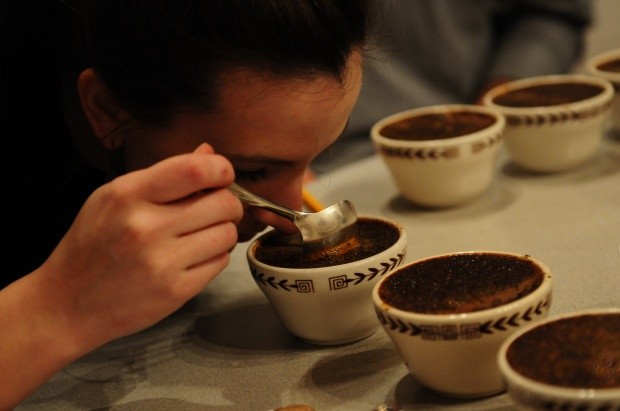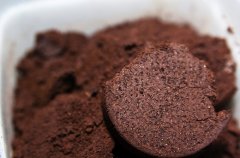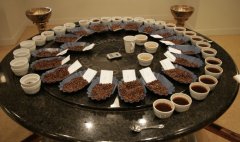Coffee cup test | Common terms for general cup test

For professional baristas, please follow the coffee workshop (Wechat official account cafe_style)
Previous articles have mentioned that the way to evaluate coffee is called "cup test", and the common special language for cup testers to discuss the pros and cons of coffee beans is as follows:
(01) Black Beans: black beans, generally speaking, refers to fruits that are harvested too late, fall to the ground too early, or beans that are too ripe.
(02) Black Jack: moldy beans, the smell of green beans changed from green to black, moldy, or mixed with other items due to improper transportation and preservation.
(03) Brokens: broken beans, peeling and improper handling in the screening process, resulting in coffee beans breaking.
(04) Clean: clean beans, high-grade beans without defects.
(05) Color: color, from dark green, yellow-green to brown. And other different colors, depending on the origin, new and old varieties, treatment process, maturity, storage, transportation.
(06) Defects: defective beans, including shells and deformed beans.
(07) Fine: preferred beans, suitable for making high-quality coffee beans.
(08) Flat: flat beans, lack of acid, lifeless beans.
(09) Full: full beans, this title belongs to beans with good sour taste and rich characteristics, with obvious and strong characteristics.
(10) Grassy: grass beans, beans with a unique and strong grass flavor, generally belong to the flavor of precocious Arabica beans.
(11) Hard bean: hard beans, grown in highlands, mild texture, slow growth period, unique characteristics, suitable for roasting high-quality coffee beans.
(12) Harsh: astringent beans, describing rough, rotten beans.
(13) Muddy: dirty beans, beans with monotonous and blurry texture.
(14) Pointed: sharp beans, describing beans with a sharp sour taste of good quality.
(15) Rich: fat beans, beans that are full of vitality and flavor.
(16) Screen: a screening net, a mesh tool used to classify the size of raw bean particles.
(17) Smooth: mild beans, coffee with good texture but lack of acid.
(18) Thin: thin beans, monotonous, lack of vitality, weak texture and lack of acid in coffee, sometimes due to lack of extraction resulting in lack of acid.
(19) Unwashed: dried beans, the peel, pulp and silver skin should be removed after harvest before they can be shipped to market. There are two methods: 'washing type' and 'drying type'. The coffee beans treated by drying natural drying method are dried beans.
44545646545.jpg
P1090371.JPG
Important Notice :
前街咖啡 FrontStreet Coffee has moved to new addredd:
FrontStreet Coffee Address: 315,Donghua East Road,GuangZhou
Tel:020 38364473
- Prev

The ingenious use of coffee grounds for waste utilization
Professional barista communication please pay attention to the coffee workshop (Wechat official account cafe_style) originally thought to be useless, but not, a simple change of mind, unlimited use, reuse also makes the environment better. Coffee beans are ground and brewed to form a delicious cup of coffee, the taste is dazzling, but what about the rest of the coffee grounds? Throw it in the trash? No, no! Please don't.
- Next

Coffee evaluation method and operation procedure explanation
Professional barista communication please pay attention to the coffee workshop (Wechat official account cafe_style) a perfect cup of coffee, the most important thing is the aroma, consistency and flavor, the quality of coffee depends on the cup tester's precise tongue and sensitive nose. And how to evaluate the quality of coffee is also a subject of knowledge, interested friends, can refer to this practice. Cupping (cup test): evaluate coffee products
Related
- What ratio of water temperature and ground does the smart cup method use to press coffee? The difference between brewed coffee and filtered coffee?
- What is the standard process for the purpose of coffee cup testing? What is the difference between hand-brewed coffee and cup testing?
- How to use hand-brewed coffee paragon small golden balls? How does cold coffee lock in the aroma of coffee?
- Is American coffee black? What is the difference between American coffee and drip coffee?
- Unexpected! Well-known tea beverage brand Lele Tea will withdraw from the Zhengzhou market!
- Starbucks enters the fashion and beauty industry?! Netizen: Give me an ice American eye cream
- Why can American refills for free? The difference between Americano and American drip pot coffee
- Being chased out of the rain in front of Starbucks?! Store: Sheltering from rain under umbrellas poses a safety hazard
- The white moonlight has changed?! Lucky launches "Big Winter Pear American"
- Hand-brewed coffee three-stage method, high-sweet and universal brewing method to share! What does the high sweet water level of hand-brewed coffee mean?

